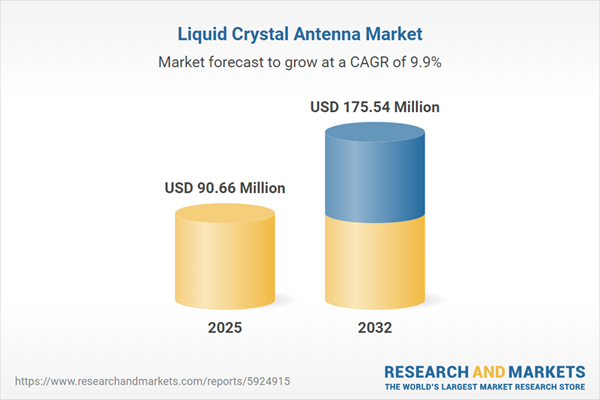Speak directly to the analyst to clarify any post sales queries you may have.
Senior executives prioritizing resilient digital infrastructures are focusing on advanced connectivity solutions like liquid crystal antenna technology. As enterprise demands for adaptive, secure, and future-ready networking environments intensify, these antennas are emerging as a compelling choice across critical industry sectors.
Market Snapshot: Liquid Crystal Antenna Market Overview
The liquid crystal antenna market is undergoing substantial growth, in response to the increasing need for scalable and reconfigurable wireless systems. With a projected compound annual growth rate (CAGR) of 9.90% from 2024 to 2032, the market is evolving rapidly. Senior leaders are tracking how these antennas align with evolving security and operational requirements across core sectors, such as networking, satellite communications, aerospace, and automotive. These trends are reinforced by sustained investment in research and development, which drives innovation and broadens the technology’s impact within enterprise connectivity strategies.
Scope & Segmentation: Liquid Crystal Antenna Market
- Applications: Supports secure in-flight communications, enhances transportation networks through real-time data, and powers compact, high-performance consumer electronics.
- Defense and Telecom Applications: Delivers critical support for electronic warfare, missile guidance, 5G and IoT integration, satellite network solutions, and robust microwave backhaul for infrastructure resilience.
- Product Types: Offers conformal, analog phased arrays, digital phased arrays, and planar designs; certain products utilize optical, thermal, or voltage-based tuning for optimal performance across diverse signal conditions.
- Frequency Bands: Operates across C-Band, Ka-Band, Ku-Band, L-Band, S-Band, and X-Band, addressing the need for specialized frequency support in defense, ground operations, and mobile applications.
- End Uses: Ensures dependable performance for aerospace initiatives, automotive integration, telecom operations, and mission-critical defense systems.
- Deployment Scenarios: Enables flexible deployment at enterprise sites, on mobile platforms such as vehicles and aircraft, as well as within limited-duration and project-specific setups.
- Regional Coverage: Extends to North America, Latin America, Europe, the Middle East, Africa, and Asia-Pacific. Notable momentum is present in the United States, Europe, China, and India, influenced by policy support and investments.
- Key Companies Analyzed: Features participants such as Merck KGaA, DIC Corporation, LG Chem Ltd, JNC Corporation, China National Bluestar (Group) Co., Ltd., JSR Corporation, Sumitomo Chemical Co., Ltd., DuPont de Nemours, Inc., BASF SE, and Mitsubishi Chemical Corporation, each fostering sector innovation and stable supply chains.
Key Takeaways: Strategic Insights for Decision-Makers
- Integration of liquid crystal antenna solutions fortifies connectivity by adapting to regulatory shifts and evolving enterprise needs.
- Collaboration among manufacturers, materials suppliers, and system integrators enhances system reliability and resilience, particularly in high-complexity deployments.
- Adopting modular, flexible architectures supports adaptable network upgrades as organizations respond to compliance updates and procurement challenges.
- Expansion of autonomous and connected vehicle initiatives is accelerating cross-industry partnerships and collaborative research into next-generation connectivity.
- Active participation in standards-setting and pilot program investments facilitates efficient technology adoption and operational transitions.
- Organizations gain network continuity and operational stability during periods of business transformation by leveraging adaptive connectivity solutions.
Tariff Impact: Supply Chain and Design Strategies
Recent United States tariff measures have led to increased supply chain costs for liquid crystal antenna producers. Organizations are responding with investments in regionalized manufacturing, moving operations closer to major end users, and expanding supplier networks to reinforce resilience. There is a greater focus on modular hardware design, which delivers operational flexibility amid changes in the international trade environment. Companies are strengthening vertical integration and focusing on robust regulatory compliance to maintain stable operations across their global footprint.
Methodology & Data Sources
This assessment leverages expert interviews, in-depth analysis of technical literature, regulatory reviews, and patent landscape studies. Advanced modeling techniques provide actionable insights specifically tailored to senior leadership and strategic planning requirements.
Why This Report Matters
- Equips senior decision-makers with data-backed segmentation and deep analysis of liquid crystal antenna deployment strategies.
- Clarifies how shifting regulations, industry collaboration, and sustained technological advancement are shaping the evolution of resilient wireless connectivity architectures.
- Guides organizations in evaluating technology integration and operational upgrades as market and regulatory requirements change.
Conclusion
Focused investment in liquid crystal antenna solutions strengthens enterprise networks and prepares organizations for coming opportunities. Effective planning and cohesive cross-sector coordination enable successful technology adoption and integration.
Additional Product Information:
- Purchase of this report includes 1 year online access with quarterly updates.
- This report can be updated on request. Please contact our Customer Experience team using the Ask a Question widget on our website.
Table of Contents
3. Executive Summary
4. Market Overview
7. Cumulative Impact of Artificial Intelligence 2025
Companies Mentioned
The companies profiled in this Liquid Crystal Antenna market report include:- Merck KGaA
- DIC Corporation
- LG Chem Ltd
- JNC Corporation
- China National Bluestar (Group) Co., Ltd.
- JSR Corporation
- Sumitomo Chemical Co., Ltd.
- DuPont de Nemours, Inc.
- BASF SE
- Mitsubishi Chemical Corporation
Table Information
| Report Attribute | Details |
|---|---|
| No. of Pages | 187 |
| Published | October 2025 |
| Forecast Period | 2025 - 2032 |
| Estimated Market Value ( USD | $ 90.66 Million |
| Forecasted Market Value ( USD | $ 175.54 Million |
| Compound Annual Growth Rate | 9.9% |
| Regions Covered | Global |
| No. of Companies Mentioned | 11 |









